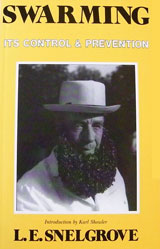
Swarming is the honeybees method of reproduction. Swarming acts to increase numbers of honeybee colonies by producing new queens to head these new colonies. Not every colony of honeybees will swarm every year. The factors that contribute to swarming are several and it is unknown whether pressure from individual factors or a combination of these factors are what contribute to swarming.
Some examples of these possible factors include, overcrowding, overheating, reduced levels of queen substance (distributed amongst the workers perhaps from an ailing queen or indeed if overcrowding is occurring) or even a strain of bees with reputed ‘natural swarminess’.
The reason why swarming needs to be controlled by the beekeeper is that the prime swarm headed by the original queen will leave the hive with half or more of the workers to set up home elsewhere. This means the rapid loss of half the bees that act as foragers and therefore half the nectar gathering, honey producing workforce! The old queen leaves the hive to allow the completion of raising and if prudent, subsequent swarming of one or more new queens thus giving honeybee reproduction!
In order to try and prevent swarming the management of the colony has to be such so as to offset the above factors. Give the bees plenty of room, super early. Try to keep a young vigorous queen which should allow for enough queen substance to keep the workers happy to stay put! The double edged sword is that such queens can be reputed to head ‘swarmy’ colonies?! Last but not least, if your bees are hell bent on swarming they will do just that. This said, ensure that you have an Artificial swarm / swarm control strategy in mind to use should you find (swarm) queen cells during a regular inspection.
When a swarm initially leaves the hive, often the bees only travel a short distance and hang up on a nearby tree branch or the likes. At this stage the scout bees are out searching for a new home and the bees in the swarm are clustering around the queen to keep her safe. Before leaving the hive the bees have taken on board the equivalent of a substantial packed lunch, gorging themselves with honey stores to enable them to quickly set up home at their new site! The longer it takes to find a new place to call home the more of these stores are used and the more restless and hungry the bees get, hence the relative docility of a new swarm as opposed to one that has been ‘hanging’ around for some time.
Whereas we do not advocate testing this theory by modelling a bee beard like L.E.Snelgrove (right), this just goes to show that the new swarm of bees really is happy, and quite unaggressively prepared, to hang around!!
The BBKA provides some excellent information on swarming, links to which are provided below